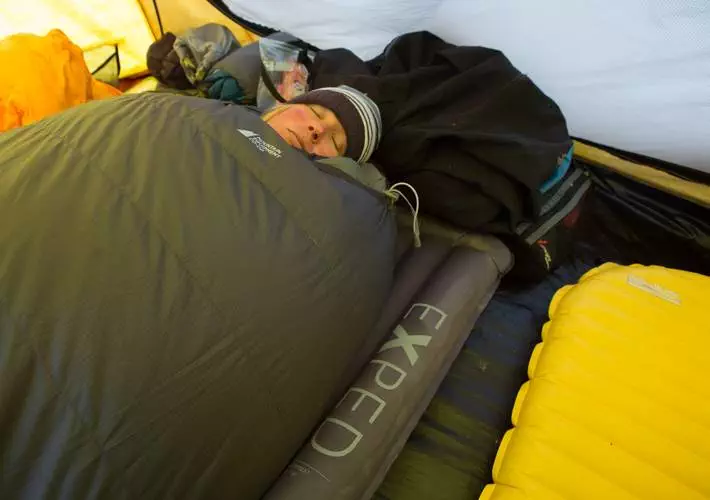Every weekend of the summer tens of thousands of Canadians load up their vehicles and bed down in campsites across the country. While car camping has its conveniences and comforts, we at MSAA like to wander a bit further from our vehicles before making camp. That means a slightly different choice of gear, particularly when sleeping in the wilderness. As the main interface between your body and the outside elements, your sleeping bag can make or break your camping experience in the mountains. To that end, we’ve rounded up some tips on:
- Buying the right sleeping bag for you
- Using and maintaining it for maximum warmth and comfort

Choosing the right sleeping bag
If you want a sleeping bag that’s both portable on the trail and warm enough for cool mountain nights, it’s worth spending a bit more than what you’d find at big box store. For a favourable warmth-to-weight ratio, choose a mummy shape, which is wider at the shoulders and tapers towards the feet. Rectangular bags are far too bulky and don’t compress well into stuff sacks.
Another specification to look for when buying is the temperature rating. Outdoor shop staff generally recommend purchasing a sleeping bag with a temperature range one colder than what you expect to camp in. Minimalists will often choose a lighter fill and stay warm by wearing their down jackets and base layer insulation when sleeping.

Synthetic versus down fill
Choosing the fill material in your sleeping bag is an important decision and both options have their pros and cons. Down is regarded as the superior product with a far higher warmth-to-weight ratio, better compressibility and longer lasting durability against compression cycles. It’s also expensive and susceptible to moisture. Once wet, down loses most of its insulation and may not recover to its full insulation when dried due to clumping inside the bag’s baffles. But if you care for your down sleeping bag by making sure it’s shielded from moisture as much as possible and allow it dry out properly after each use, it will last for many years.
Synthetic fill bags retain their insulation when wet and recover easily from moisture. For this reason, they are often the choice of mountain campers dealing with rain in the Pacific Northwest. However, they are heavier and don’t compress as well as down, meaning the stowed bag will take up more room in your pack. Synthetic fibres will also break down faster after many compression-decompression cycles, which is why that old Candian Tire sleeping bag from your youth doesn’t keep you as warm anymore.
Looking after the investment
A sleeping bag will only last if you give it the proper care and maintenance. Always, always, store the bag (whether synthetic or down) uncompressed in a breathable storage sack (usually sold with the sleeping bag) or in a pinch, a large garbage bag. This is to avoid damage to the insulation material. If you lack sufficient storage, you can always lay it out uncompressed under your bed.
Moisture will inevitably make its way into your sleeping bag with condensation, perspiration, rain, dew and frost. Try to dry it out of direct sunlight if possible as UV rays can damage some face materials, but getting your bag dry is the priority. Compressing wet down means it won’t insulate until it’s fully dry again, which can be a trip-ender in cold or wet climates.
When the bag inevitably gets dirty or begins to stink, it’s time to wash. Never use regular laundry detergent as it can strip the natural oils from down fibers, so make sure you use a specialized down wash liquid such as Nikwax or Grangers. Synthetic base layer wash can be used for synthetic bags.
Always try to keep your bag out of the way of sharp or heavy objects such as shoes, sticks, rocks or mountaineering tools. Patch any holes as soon as you notice them (duct tape is an excellent field repair) before compressing the sleeping bag. If there’s extensive damage, consider sending it back to the manufacturer for repair.

Living with the choice
If you’re serious about camping in the mountains then down is the logical choice for comfort and utility. An important consideration when buying any down, however, is how the material is sourced. Down is made of the fine fibres and plumes from the stomach feathers of geese. Cheap down products have little to no traceability, meaning it could come from farms where geese are live plucked and mistreated. Always buy down from a reputable brand and ask about ethical sourcing when purchasing.
Take the time to research when buying your sleeping bag and you’ll sleep easier.
Over the next few weeks, Mountain Skills Academy & Adventures will be bringing you a blog series on how to stay comfortable camping in the mountains.




